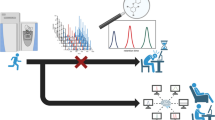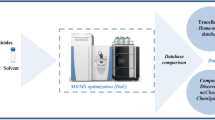Abstract
Liquid chromatography–high resolution mass spectrometry (LC-HRMS) is a well-established technique for nontarget screening of contaminants in complex environmental samples. Automatic peak detection is essential, but its performance has only rarely been assessed and optimized so far. With the aim to fill this gap, we used pristine water extracts spiked with 78 contaminants as a test case to evaluate and optimize chromatogram and spectral data processing. To assess whether data acquisition strategies have a significant impact on peak detection, three values of MS cycle time (CT) of an LTQ Orbitrap instrument were tested. Furthermore, the key parameter settings of the data processing software MZmine 2 were optimized to detect the maximum number of target peaks from the samples by the design of experiments (DoE) approach and compared to a manual evaluation. The results indicate that short CT significantly improves the quality of automatic peak detection, which means that full scan acquisition without additional MS2 experiments is suggested for nontarget screening. MZmine 2 detected 75–100 % of the peaks compared to manual peak detection at an intensity level of 105 in a validation dataset on both spiked and real water samples under optimal parameter settings. Finally, we provide an optimization workflow of MZmine 2 for LC-HRMS data processing that is applicable for environmental samples for nontarget screening. The results also show that the DoE approach is useful and effort-saving for optimizing data processing parameters.

ᅟ






Similar content being viewed by others
References
Schwarzenbach RP, Escher BI, Fenner K, Hofstetter TB, Johnson CA, von Gunten U, et al. The challenge of micropollutants in aquatic systems. Science. 2006;313(5790):1072–7.
Hug C, Ulrich N, Schulze T, Brack W, Krauss M. Identification of novel micropollutants in wastewater by a combination of suspect and nontarget screening. Environ Pollut. 2014;184:25–32.
Ruff M, Mueller MS, Loos M, Singer HP. Quantitative target and systematic non-target analysis of polar organic micro-pollutants along the river Rhine using high-resolution mass-spectrometry – identification of unknown sources and compounds. Water Res. 2015;87:145–54.
Hernandez F, Ibanez M, Portoles T, Cervera MI, Sancho JV, Lopez FJ. Advancing towards universal screening for organic pollutants in waters. J Hazard Mater. 2015;282:86–95.
Krauss M, Singer H, Hollender J. LC-high resolution MS in environmental analysis: from target screening to the identification of unknowns. Anal Bioanal Chem. 2010;397(3):943–51.
Zhang W, Chang J, Lei Z, Huhman D, Sumner LW, Zhao PX. MET-COFEA: a liquid chromatography/mass spectrometry data processing platform for metabolite compound feature extraction and annotation. Anal Chem. 2014;86(13):6245–53.
Smith CA, Want EJ, O'Maille G, Abagyan R, Siuzdak G. XCMS: processing mass spectrometry data for metabolite profiling using nonlinear peak alignment, matching, and identification. Anal Chem. 2006;78(3):779–87.
Katajamaa M, Miettinen J, Orešič M. MZmine: toolbox for processing and visualization of mass spectrometry based molecular profile data. Bioinformatics. 2006;22(5):634–6.
Pluskal T, Castillo S, Villar-Briones A, Orešič M. MZmine 2: modular framework for processing, visualizing, and analyzing mass spectrometry-based molecular profile data. BMC Bioinf. 2010;11(1):395.
Allen F, Greiner R, Wishart D. Competitive fragmentation modeling of ESI−MS/MS spectra for putative metabolite identification. Metabolomics. 2014;11(1):98–110.
Rasche F, Scheubert K, Hufsky F, Zichner T, Kai M, Svatoš A, et al. Identifying the unknowns by aligning fragmentation trees. Anal Chem. 2012;84(7):3417–26.
Wolf S, Schmidt S, Müller-Hannemann M, Neumann S. In silico fragmentation for computer assisted identification of metabolite mass spectra. BMC Bioinf. 2010;11(1):148.
Schymanski EL, Jeon J, Gulde R, Fenner K, Ruff M, Singer HP, et al. Identifying small molecules via high resolution mass spectrometry: communicating confidence. Environ Sci Technol. 2014;48(4):2097–8.
Schymanski EL, Singer HP, Slobodnik J, Ipolyi IM, Oswald P, Krauss M, et al. Non-target screening with high-resolution mass spectrometry: critical review using a collaborative trial on water analysis. Anal Bioanal Chem. 2015;1–19.
Hibbert DB. Experimental design in chromatography: a tutorial review. J Chromatogr B. 2012;910:2–13.
Hecht ES, Oberg AL, Muddiman DC. Optimizing mass spectrometry analyses: a tailored review on the utility of design of experiments. J Am Soc Mass Spectrom. 2016;1–19.
Livingstone D. Data analysis for chemists. Oxford: Oxford University Press; 1995.
Laures AMF, Wolff J-C, Eckers C, Borman PJ, Chatfield MJ. Investigation into the factors affecting accuracy of mass measurements on a time-of-flight mass spectrometer using design of experiment. Rapid Commun Mass Spectrom. 2007;21(4):529–35.
Seto C, Bateman KP, Gunter B. Development of generic liquid chromatography-mass spectrometry methods using experimental design. J Am Soc Mass Spectrom. 2002;13(1):2–9.
Gruendling T, Guilhaus M, Barner‐Kowollik C. Design of experiment (DoE) as a tool for the optimization of source conditions in SEC‐ESI‐MS of functional synthetic polymers synthesized via ATRP. Macromol Rapid Commun. 2009;30(8):589–97.
Lemonakis N, Skaltsounis A-L, Tsarbopoulos A, Gikas E. Optimization of parameters affecting signal intensity in an LTQ-orbitrap in negative ion mode: a design of experiments approach. Talanta. 2016;147:402–9.
Zhou Y, Song J-Z, Choi FF-K, Wu H-F, Qiao C-F, Ding L-S, et al. An experimental design approach using response surface techniques to obtain optimal liquid chromatography and mass spectrometry conditions to determine the alkaloids in Meconopsi species. J Chromatogr A. 2009;1216(42):7013–23.
Zhang L, Borror CM, Sandrin TR. A designed experiments approach to optimization of automated data acquisition during characterization of bacteria with MALDI-TOF mass spectrometry. PLoS ONE. 2014;9(3):e92720.
Jalali-Heravi M, Parastar H, Sereshti H. Towards obtaining more information from gas chromatography–mass spectrometric data of essential oils: an overview of mean field independent component analysis. J Chromatogr A. 2010;1217(29):4850–61.
Eliasson M, Rännar S, Madsen R, Donten MA, Marsden-Edwards E, Moritz T, et al. Strategy for optimizing LC-MS data processing in metabolomics: a design of experiments approach. Anal Chem. 2012;84(15):6869–76.
Zheng H, Clausen MR, Dalsgaard TK, Mortensen G, Bertram HC. Time-saving design of experiment protocol for optimization of LC-MS data processing in metabolomic approaches. Anal Chem. 2013;85(15):7109–16.
Libiseller G, Dvorzak M, Kleb U, Gander E, Eisenberg T, Madeo F, et al. IPO: a tool for automated optimization of XCMS parameters. BMC Bioinf. 2015;16(1):1–10.
Brack W, Ait-Aissa S, Burgess RM, Busch W, Creusot N, Di Paolo C, et al. Effect-directed analysis supporting monitoring of aquatic environments—an in-depth overview. Sci Total Environ. 2016;544:1073–118.
MZmine Development Team. MZmine 2.10 manual. 2005–2012.
Lenth RV. rsm. 2.07 ed, 2014.
Acknowledgments
The authors gratefully acknowledge the support by the European Marie Curie Initial Training Network EDA-EMERGE (grant agreement no. 290100), the European FP7 Collaborative Project SOLUTIONS (grant agreement no. 603437). MH was support by EDA-EMERGE (ESR09) and the HIGRADE Graduate School of the Helmholtz Centre for Environmental Research–UFZ.
Author information
Authors and Affiliations
Corresponding authors
Ethics declarations
Conflict of interest
The authors declare that there is no conflict of interest.
Electronic supplementary material
Below is the link to the electronic supplementary material.
ESM 1
(PDF 634 kb)
Rights and permissions
About this article
Cite this article
Hu, M., Krauss, M., Brack, W. et al. Optimization of LC-Orbitrap-HRMS acquisition and MZmine 2 data processing for nontarget screening of environmental samples using design of experiments. Anal Bioanal Chem 408, 7905–7915 (2016). https://doi.org/10.1007/s00216-016-9919-8
Received:
Revised:
Accepted:
Published:
Issue Date:
DOI: https://doi.org/10.1007/s00216-016-9919-8




